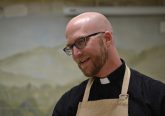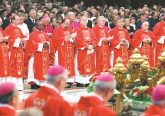The Catholic Moment: The mystery and gift of the priesthood
Wednesday, April 8, 2009
By Father Kyle Schnippel
One saint stands out in a particular way among parish priests. Known for his own personal holiness, his doggedness in completing seminary and his dedication to time in the confessional, St. John Marie Vianney, the Curé of Ars, is called upon to provide patronage and guidance for all parish priests of today.
Living during the tumultuous times following the French Revolution, he was sent to Ars, a village in southwest France, simply to give him a place that was out of the way. It was an area particularly hard hit by the chaos that ensued after the Revolution, when many priests and religious either gave up their faith, or were martyred because of it. It was thought that because the faith was already dead there, he could not do any damage.
But into this spiritual vacuum, John Vianney appeared with nearly reckless abandon. A model of prayer for his people, he spent several hours a day before the Blessed Sacrament, as well as up to 15 hours a day during the summer in the confessional, freeing his people from their sins and reawakening them to the richness of God’s mercy and His call to be disciples. His confessional quickly became a place of pilgrimage, as his fame for holiness and compassion spread throughout France.
His tremendous work in the face of long odds and an openly hostile culture has led Pope Benedict XVI to declare St. John Vianney as not just patron of parish priests, but now as patron of all priests, no matter their area of service. In doing so, and also noting that this is the 150th anniversary of the death of this saintly curate, Pope Benedict has also declared a special “Year for Priests’” to begin on June 19 of this year.
To anticipate why this year is needed, Pope Benedict remarks that it is easy for even the priest himself to see his life and ministry solely in the terms of the function he provides for the people placed in his care. It is easy to see the priest as a mere dispenser of sacraments for the people, rather than as a living icon of Christ, for he priest participates in a unique way in Christ’s “tri-muneral” office of priest, prophet and king. So that as Jesus is the head and shepherd of the church, the priest becomes the father of a parish, shepherding and guiding his people not to himself, but to Christ. He is a doorway beyond himself.
Yet a priest is not a priest for himself, and he faces a constant tension that while he is working out his own salvation, he must also in turn help others on their path of salvation. In a very real sense, he becomes the model and example for his people to follow. Therefore, the priest must strive for his own spiritual and moral perfection, for he must lead others to that same perfection.
As grand as this vision is, one quickly realizes that he cannot do this on his own. Rather, the church becomes a family so that as he lays down his life for his people, they also support and nourish him by their prayers. Only with this interconnectedness in faith are we able to fulfill our Lord’s command to spread the Gospel to the ends of the earth.
To encourage this family dynamic of prayer, the archdiocesan Vocation Office sponsors an apostolate of prayer for priests: St. Michael Prayer Warriors. Our next conference is approaching soon — April 26 at Our Lady of the Holy Spirit Center in Norwood, and May 3 at St. Rita’s Catholic Church in Dayton. For more information on this conference, see http://cincinnativocations.org/prayerwarriors.shtml.
During this forthcoming “Year for Priests,” let us all take advantage of the opportunity to study more about the great gift and mystery that is the Catholic priesthood. Let us strive to pray for each other, to encourage each other in holiness, so that we may experience a great tide in vocations to the priesthood, and a renewal of the faith among all our brothers and sisters in Christ.













